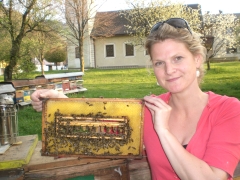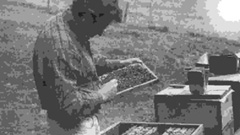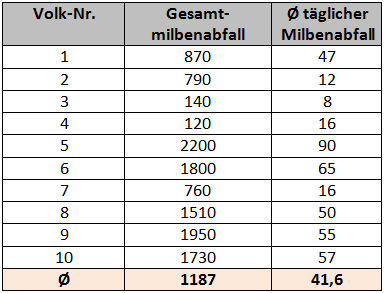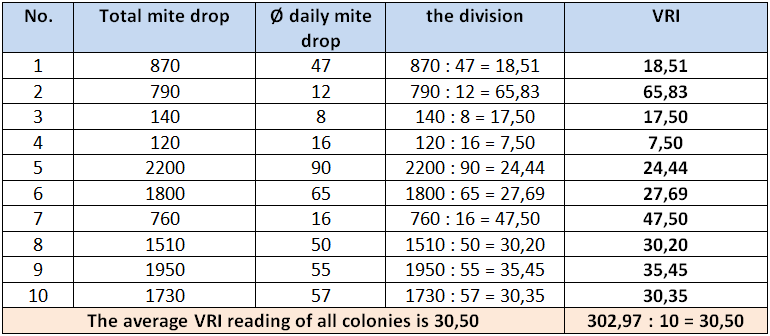>> Biological Beekeeping<<
Alois Wallner
Perwarth 7
3263 Randegg
Austria
Tel.: 0043-7487-8386
Approved breeding farm of BIO-AUSTRIA AT-BIO-302
Control Authority AUSTRIA BIO GARANTIE

order queens easily per email!
mail to: alois.wallner@voralpenhonig.at
Selection and breeding for Varroa resistance
Breeding in general is understood to mean the process in which the breeder makes an appropriate choice among the mating animals, in which the desired properties are even more consolidated and developed.

In my breeding, the desired characteristic is the killing of varroa mites by the bees. In order to make this property measurable, I created in 1990 the measured value Varroakiller factor (VKF). With this measured value, it is possible for me to graphically show the change of the desired property:
Conclusion:
New pairings have been made every year for the past 28 years. From 60 to 100 bee colonies each year in September, the Varroa Killer Factor (VKF) was determined.
Of the bee colonies with the highest VKF, the newest breeding colonies were selected and used for breeding next year.
Particularly interesting in the graph, I find that several times in a few years no percentage increase in the VKF took place.
The explanation for this is probably that only an increase was possible when drones of the new breed were available for mating.
The last years of the graphic clearly prove a strengthening of the desired property in the genetic material of my breeding.
This consolidation is the prerequisite for the next step in my selection and breeding.
In 2009, I started with a special selection.
With this selection, I now select bee colonies, which not only detect a high VKF, but are also very fast in catching and killing Varroa mites.
From practice:
With a high VKF, of an average of 96% of the breeding colonies, I do not need any final deciduous in autumn and winter among my colonies.
The bees sufficiently defile themselves if no reinfection takes place from the outside.
28 years of varro resistence selection and breeding.
Since 1989, I have been intensively involved in the selection and breeding of bees that have already identified the Varroa mite as an enemy by intercepting and killing them. In 1994 I had my experience and a book with the title "Varroaresistent" self-published. Since then, several decades have passed, so the question arises:
Has anything changed measurably during this time through selection and breeding?
Yes, a lot has changed. The Varroa mite has become more dangerous for the bees. At that time I had been able to keep my breeding people with relatively large mite infestation for five years without any treatment.
That would not be possible today. The bees have become more sensitive, they only endure more low numbers of infestations without taking damage.
On the other hand, my breeding has become more aggressive against the Varroa mite. The bees kill more mites than ever before.
The average VKF (Varroa Killer Factor describes the ratio of killed mites to total mite mite) has increased from 27% to over 95% in 28 years.
The question now is: How does this high reading of over 95% VKF affect the actual Varroa infestation of such colonies?
To question this, I have determined the average daily mite waste in my breeding peoples on 31. 7. 2017.
On August 1, 2017, I began to demotify these peoples. Method: shock treatment with formic acid. The resulting mite was counted in the following 12 days.
In order to check the effectiveness of this demolition, I decided to join a control treatment.
The last defoliation of these breeding Colonies was end of August 2016. From early September 2016 to August 1, 2017, no demilitarization was performed, either an oxalic acid treatment or drone removal.
The measured values of the breeding colonies 2017:

Measurable and recognizable Varroa resistance!
The daily varroa drop before defoliation in relation to the actual varroa waste after defoliation.
Discussion: An average mite drop with 41.6 mites per colonie and day of the 10 test populations yields according to the conventional extrapolation estimated (daily mite drop x 100-300) a average total infestation per colonie of approx. 10,000 mites per colonie.
How is this big difference explained? In the daily natural mite drop are among my breeding colonies also mites, which were killed by the bees themselves.
According to the table of 10 peoples daily 41.6 mites per colonie and per day.
The VKF of 95% in the mite drop indicates that the bees of these colonies kill many Varroa mites daily, which ultimately results in an inhibited infestation all year round.
An interesting observation for me: In the countless investigations of mites, which were killed by the bees, I made an impressive observation:
Increasingly, I found killed Varroa mites with only one or both of their antennae separated at the tip.
With the same VKF, the number of mites killed was twice as high in such colonies as in colonies who only cut off their legs.
In my opinion, the bees have learned that it is easier to separate only the antennae of the mites, because they are always unprotected from the mite skin.
It is therefore very clear from this observation that some colonies have learned to defend themselves better against the enemy "Varroa" than others.
To recognize and measure this natural varroa defense requires at least a period of 10-11 months without any treatment.
Summary: 28 years of selection and breeding for the characteristic varroakiller factor have changed the daily mite fall to the actual Varroa fall.
The varroa resistance of my breeding colonies has improved steadily and sustainably over the years.
The Varroa infestation in the breeding colonies is permanently inhibited by the constant killing of the mites by the bees.
This Varroa resistance allows further reduced control of the Varroa mite.
The assessment of the measured values ??of several breeding colonies reveals the possibility of a further improvement in varroa resistance.

An example of my breeding colonies: A very good honey performance and gentleness are prerequisites for a selection for Varroa resistance!
The VARROARISIST INDEX (VRI)
My new reading for the assessment of Varroa resistance of my Carnica breeding strain.
The collected readings of my breeding bee colonies in the table are very meaningful for me. However, those who are not so intensively concerned with the Materia, these numerical values ??in the assessment at first glance rather confusing. There is no common denominator for their simple assessment.
My problem: For more than two decades, my selection and breeding for varroa resistance has focused on the assessment of the killing of varroa mites by bees. The measured value for this selection is still the VKF. This reading has averaged over 95% in my bee colonies for many years. Maintaining control of this metric is still very important to me. Since this reading is very close to the 100% mark, further selection is no longer possible in this.
Looking for a new metric for further selection for varroa resistance.
It should be a reading that allows me to collect, measure, and then easily assess all known and potentially unknown resistance properties.
The result of my search of many years: the value VARROARESISTENZINDEX (VRI)
The basis for this new resistance value is the varro resistance test. The performance of this test I described in detail in the first section.
The result of this test are two readings for each colonie. First, the average daily mite rate before defoliation. Second, the total mite decline after defoliation. I subject these two readings to a division. The result of this division is my new reading VARROARESISTENZINDEX (VRI).
Below in the table the individual divisions. In the far right column the calculated individual values ??of the new measured value VRI. All resistance values ??added together and divided by ten - ie the number of tested peoples - gives the average VRI of 30.50. With a range of 7.50 to 65,83 VRI.

Table 1: Measured values at the end of July 2017
The assessment of the measured values VRI.
The lower the VRI reading the better my assessment. A lower reading, ie VRI below 20, means fewer Varroa mites in the population than a reading VRI above 50. A reading of VRI greater than 100 means no appreciable Varro-resistance.
The group winner of this varro resistance test is the people No. 4 in the table.
This colonie No. 4 can prove the best reading VRI of 7.50. This means: average daily mite drop 16 mites before demilification, are opposed to the reading of 120 mite drop due to the mite. The division of these two readings gives the peak reading of 7.50 VRI.
The average VRI of all ten test colonies is 30.50. With a bandwidth of 7.50 to 65.83 reading VRI. In the coming years, I will assess the expected breeding progress in the varroa resistance of my breeding peoples using this reading from the breeding year 2017.
However, this calculated index value has another important meaning.
Because this measured value is at the same time the approximately actual conversion factor for the estimation of the varroa infestation of individual breeding colonies without demilification.
An example: The average daily mite drop x 30.50 VRI gives the estimated Varroa infestation without varroa mite treatment.
The big difference:
For colonies without varroa resistence, the conversion factor is 100 to 300 for the estimated total infestation.
My preliminary breeding goal:
An average VRI of the breeding colonies below the reading of 20. From my point of view, for treatment-free peoples for a few years a VRI is under 10 precondition.
An inheritance test from the breeding year 2017, with my favorite breeding colonie No. 9.
The breeding colonie no. 9 in the table shows honey performance above average over many years. The bees of this breeding people are extremely gentle. The VKF (varroa killer factor) is over 95%. According to the table, the newly created measured value VRI is 35.45, ie a somewhat worse measured value than the average of all test colonies with the measured value VRI of 30.50.
At the beginning of May 2017, I have sheltered ten mated queens of this breeding stock in ten large stocks with 12 brood combs. These offshoots were not subject to any mite! At the end of July 2017, I performed the Varro-resistance test in the form already described among these ten colonies.
The result of this resistance test:
The VRI of all ten colonies has an average reading of 34.15. This is about 1 percentage point better than the parent population with the index of 35.45.
Summarized the group metrics:
Three colonies of this group had excellent VRI readings of 14.1, 18.8 and 20. This gives the very good average resistance value of 17.4.
Four colonies of this group had an average index of 32.9. Three colonies, however, had a worse VRI reading than the mother race. The average of these three peoples is 51.8.
Not included in this heredity test are the honey performance and the evaluation of gentleness. These properties will be rated 2018 this year. Only then I decide which colonies will be used for further breeding.
My new reading VRI has thus passed the test with the examination of the descendants of my favorite breeding colonie No. 9 on the property Varroa resistance. A further selection and increase of varroa resistance of my breeding strain is possible.
Varro resistance, the measurements of my breeding peoples for the breeding year 2020
The bee year 2018
In this breeding year I have formed over 100 offshoots. The breeding peoples came from 2 lines, all of which have a varro resistance index VRI * of no more than 25 points.
*The VRI is the ratio of daily mite decay before defoliation to actual defoliation after defoliation. The lower the VRI index, the better the Varroa resistance. More at the end of the article.
These peoples were last demilified with formic acid on September 12, 2018 and were sintered to 2 units (Freudenstein measure). For 10 months, from 12 September 2018 to the end of July 2019, no demilification was carried out and no drone brood was taken.
The selection of these colonies in the bee year 2019
Within the framework of the selection, the following peoples divorced:
✓ Peoples with delayed release of hives
✓ Peoples, who were restless or almost aggressive
✓ Peoples, who have raved
✓ Peoples, which only reached the standard average in the honey yield
✓ Peoples, which Slightly weaker at the end of July
✓ Peoples who achieved an index of more than 32 points in the VRI examination.
In the last week of July 2019 I did the Varroa index test with about 50 people. For this purpose, these selection peoples were brought from the receivables to the home state, since here the daily mite counts were easier to carry out time. 10 selection peoples were shortlisted.
The varro resistance test at the end of July 2019 - The results:

Table 2: Measured values at the end of July 2019
Valuation of Values
The Ø VRI Index of all peoples of this group is Ø 23.8 points. In comparison, the Ø group Ø 2017 had a Ø VRI of 30.50 points.
The lower the VRI index, the better the Varroa resistance. This improved resistance by 6.7 points (23.8 in 2019 vs. 30.50 in 2017)
affects the varroa mite count. Compared to the groups of 2017, the number of mites decreased from Ø 1187 mites to Ø
719,2 mites. The daily mite decrease before the mite has decreased from Ø 41.6 mites to Ø 29.50 mites.
The further selection
I would like to further select these 10 selection peoples on 5 peoples.
On the table I already ranked the 5 peoples with the best index scores of 1-5.
These peoples are my breeding folks next year (2020). These 5 peoples I undergo a Ø calculation.
The result of the Ø measured value of the cultivated peoples is:
✓ Ø VRI Index: 20,50 points
✓ Ø Demilification waste after 10 months: 516 mites
✓ Ø daily mite waste before defoliation 25,4 mites
Evaluation of the measured values ??of the 5 breeding peoples
The VRI compared to the whole group of 2019 has improved from Ø 23.80 points to Ø 20.50 points.
This improved index shows its effect. The defoliation number has decreased from Ø 719,2 mites to Ø 516 mites.
Also the Ø daily mite waste before the mite has decreased from Ø 29,5 mites per day to 25,4 mites.
The VARROAINDEX is the ratio of daily mite decay before defoliation to actual defoliation after defoliation.
With this index number, I can even see a slight improvement in Varroa resistance.
The comparison with the group of selection peoples of 2017 shows a very large breeding progress of the offspring.
This year I have formed about the same number of spin-offs as in 2018. These will be selected as discussed in 2020.
Fallen Varroa mites from the bees of my breeding:
Photo: Varroa mite with bitten legs

Photo: Both mite legs are severed. In a short time the death of the mite occurs.
The analysis of my new measured value varro resistance index
The daily mite decrease before the mite consists of mites, which died of old age and those mites, which were killed by the bees.
This is recognizable by injuries of the mites, mostly it is severed legs. The ratio of these two components is my reading varroakiller factor.
If the VKF is 95% or more, this means that most mites have been killed by the bees in daily mite debris prior to defoliation. This in turn contributes to an inhibited Varroa multiplication in the 10-month observation period. This Resistenz property works year-round, so in winter, if no brood is present. The other known resistance factors only work with existing brood. Eg: The opening of infested brood cells, or the infertility of some Varroen, these factors I already noted in my first selection peoples in 1990 and described in my two books "beekeepers today" (1990) and in the book "Vararist" and documented with photos. Another important factor of resistance is the low attractiveness of the brood to propagate the mites. This feature is recognizable in the mite, most mites fall off already in the first days. All resistance factors together cause an inhibited Varroa multiplication in the observation period of 10 months. But again a low desmigration number does not necessarily predicate a good Varroa resistance, a low desmling number also arises, if the people raved about or if an optimal demilification was carried out.
Summary:
The actual defoliation number divided by the Ø daily mite decay before defoliation yields the Varro-resistance Index (VRI) reading.
The higher the varro resistance of a people, the lower the VR index. For example, my 5 breeding peoples have an average VRI of 20.45 points as shown,
which means a very good Varroa resistance. A bee colony with a VRI reading of 100 or more has no natural varroa defense.
The big advantage of this resistance calculation is also that the test peoples are not exposed to any unnecessary load from the Varroa mites.